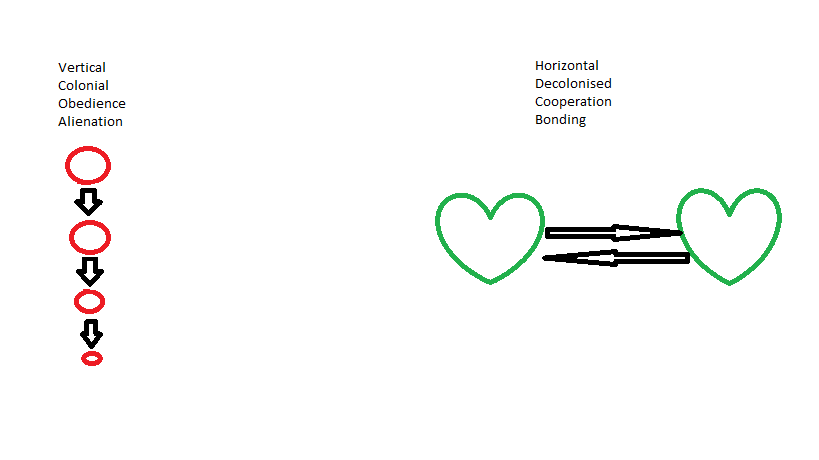
Here’s a short animation created by a young person who has experienced Horizontal Communication in action https://youtu.be/51SFZ32qugg
Different approaches to ‘Justice’:
Punitive Justice – someone must be made to suffer because of the problem.
Restorative Justice – the problem must be solved.
Transformative Justice – the causes of the problem must be addressed.
Punitive Justice – when there is a problem, someone must be to blame, and that person should be accused, proven guilty, and then made to suffer in some way because they are assumed to have ’caused’ the problem. Making them suffer is intended to motivate them to not cause such a problem again in future, and make them ‘pay’ for having caused the problem in the past. This is the mainstream approach to ‘justice’ in the WEIRD world – (Western, Educated, Industrialized, Rich, and Democratic). This approach does not challenge social systems and does not lead to social evolution.
Restorative Justice – when there is a problem, someone must be to blame, that person should be identified and held accountable. If possible they should be brought to understand the harm they have done, through a process of building empathy for the victim. The offender must redress the harm they have done. Communities may be involved in creating an appropriate way to redress the harm, and ‘restore’ or heal what has happened. The ultimate aim is also to rehabilitate the offender such that they will not cause such a problem again. This approach can lead to greater self-insight for everyone involved, leading to local change, and can sometimes inspire awareness of bigger social systems.
Transformative Justice – when there is a problem, we seek the underlying causes of the problem. We look at the social structures, values and norms that underlie the problem. We support everyone involved in healing and becoming more empowered, and work to heal and evolve the systems that generated the problem so that such problems are less likely to keep happening. This approach is evolutionary for humanity as a whole, and actively innovates on the socio-political level.
Both Restorative and Transformative Justice require some form of Horizontal Communication.
Vertical:
Oppressive communication flows down a power hierarchy. The person with the most power, the person on top, gets to talk. The person below gets to listen (and comply). Whether we try to win (get on top or stay on top) or make ourselves into martyrs (put ourselves under), we’re in Vertical mode. For every ‘win’ there must be a ‘lose’. When we disagree with someone, we compete to see “who’s right”. ‘Respect’ is interpreted as ‘deference’: deference is when you politely submit to a person with more power – even if you despise them.
Horizontal:
Horizontal communication flows between equals. Either may speak to the other, and each will listen to the other. No permission is needed for either to speak, and neither can be forced to speak or listen against their will. The experience is one of deepening connection and win-win. When we disagree with someone, we work to see what we can learn, and what creative innovation will come from our synergy. ‘Respect’ is interpreted as acknowledging the dignity, feelings, needs, and rights of others.

Vertical Communication is currently so normal in our world that we mostly don’t even realise that we’re using it. Horizontal Communication is a new set of habits that can be built with ongoing practice. Horizontal Communication can bring about a completely different quality of life experience and level of satisfaction in relationships, as well as higher quality real-world solutions and innovations that would otherwise be impossible.
The more we disagree, the more we need to listen